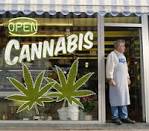A 46-year-old mother of three, Dooley is the cofounder and president of Julie’s Baked Goods, a purveyor of cannabis-infused snacks. She has celiac disease and wanted to create gluten-free products that would relieve her pain without damaging her intestine. Dooley’s Denver company released its first product, granola mixed with cranberries and almonds, in 2010 and now sells about 6,000 units a month, employing 11 people.
Even in Colorado, where medical and recreational marijuana are both legal, the cannabis business involves its share of hassles. Initially, Dooley’s license cost $1,250 and required a 25-page application. Renewing it, she said, cost more than twice that and required investing about $25,000 in the company’s kitchen, including a security system with 24-hour video surveillance. She wouldn’t have a business today if her husband weren’t a manufacturing specialist, she says.
As hard as she’s worked, Dooley’s experience has been relatively easy for a medical marijuana business in this country. Marijuana remains illegal federally, which leaves every state which allows the product to figure out its own regulations. Colorado […]











I believe that the discussion has been lost with the legalization of marijuana in a few progressive Untied States. Please allow me to digress for the remainder of this paragraph, as it’s really urbanization that is responsible for so many of these planetary ills with corporate cannibalization a natural progression of enterprise. When I visited China in 2012, now with 55 % living in urban areas, there are no longer enough peasants living in the countryside to bring in the harvests or to fight the wildfires, caused by climate change. Pot cannot be successfully marketed urban or rural. Why would people pay for something that is a weed and can be grown anywhere; city or country? The real users will continue to grow their own and bypass store bought luxuries like baked goods.
The real debate ought to center around the immense usefulness of hemp, MaryJane’s sister plant. The pages of the Guttenberg bible, nearly 1000 yrs. old I’m, told were made of hemp, naturally white, needing no chlorine (one of the most destructive chemicals released worldwide by mankind) The pages can be turned today by the monks, as if they were made yesterday. Then there is the totally hemp car, Ford made decades ago, that could be hit with a sledgehammer and not damaged. The French developed a self-insulating building block system made from the hurds or inner fibres. The softer tissues were manufactured into a type of particleboard. Trees are best left where they stand as sequesters of carbon from the atmosphere. Where I live here in Nova Scotia, the ocean is constantly washing ashore lobster trap rope of multi colours, all made from hydrocarbons (read oil) that take thousands of years to degrade and will further pollute the world’s oceans with more plastic microbeads. But keep on eating fish! The list goes on and on. The real discussion should focus on the uses of the renewable plant hemp, instead of the psychotropic uses of it’s sister/brother marijuana.
Your link doesn’t work, so I can’t read the full story….
The link has been updated